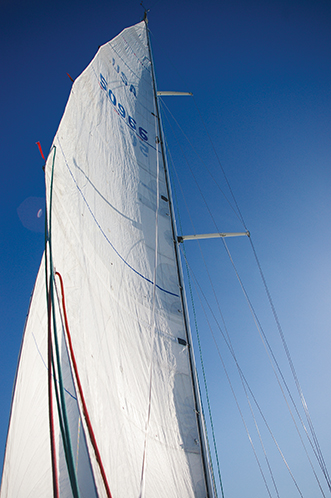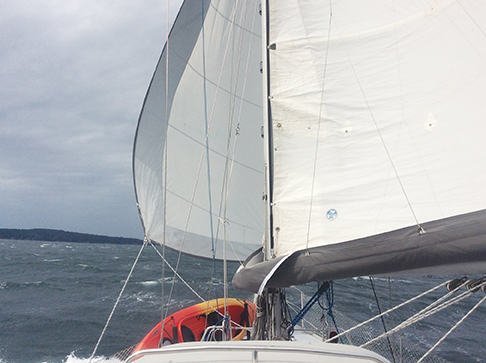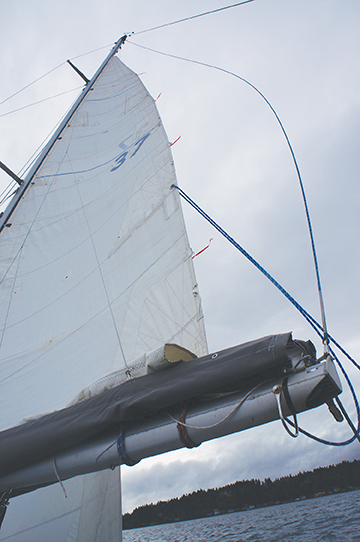Increased performance means paying attention to the little things (published June 2105)
When cruisers think of performance sailing they often think of yachts racing around buoys with crewmembers hiking out over the windward rail or scurrying around on deck while being yelled at. That doesn’t sound like the relaxing time that most cruisers are after, and it isn’t. In reality, the overall performance of your boat isn’t actually about racing at all; it’s about sailing the boat you have to the best of its ability. And most times this comes down to how you use your sails in concert with the helm in order to make the boat move just a bit more efficiently through the water.
You probably don’t need a good reason to get out for a sail, but heading out to practice using all the sail controls aboard your boat in a variety of wind conditions is a good one. An uptick in your performance may be the reward, or you may just figure out how to handle your boat better in the conditions given. Either way, here are some simple tips to try out the next time you’re out day sailing or cruising.
TWIST
Whether you are sailing close to the wind, reaching or running, sail twist is hugely important to creating an efficient and fast sail shape. When talking about sail twist, we’re referencing how the sail looks from the foot to the head and how tight the leech is. A tight leech will cause the sail to have less twist and a loose leech will leave the sail twisted open and spilling air in the top half. How much twist you want depends on what point of sail you’re on and how much wind there is.

Two control lines that help with sail twist are the mainsheet and boom vang, since they are essentially pulling down on the boom or easing it up. When sailing close-hauled, the mainsheet is your primary control to tighten and loosen the leech. Try pulling in your main and watch what happens to the leech of the sail. As the boom comes in it will, at some point, stop moving towards the middle of the boat and instead be pulled down. The point where it starts pulling down is where the sail has less twist and when you ease it back out, you can watch the leech twist open and spill air. In lighter wind you generally want to have a little more twist aloft, as the apparent wind is farther aft. And as the wind picks up, tighten up the leech to make the sail more efficient when the wind moves forward.
When reaching or running, the boom vang becomes your primary control for twist, especially in a moderate to heavy breeze when there is more pressure on the sail. Just like the mainsheet, when you tighten up the boom vang it is going to pull the leech of the sail tight and reduce twist. When it is loosened up, it will allow the top of the sail to twist open and spill air. In light to moderate breezes it is usually good to have less twist in the main so you aren’t releasing too much air off the top of the sail. Then when the wind pipes up, you can ease the vang to spill air and keep the boat under control.
For the jib or genoa, sail twist is entirely a function of where your fairlead cars are placed. Having fairleads that are adjustable from the cockpit is a real plus, but not mandatory. The basic theory here is that when the fairleads are set aft, more tension will be placed on the foot of the sail, which will flatten the bottom of the sail and spill open the leech aloft. This is a good setting in heavier air before reducing the size of the sail. Set the cars farther forward and the leech will be tightened up, leaving a round foot with maximum draft in the sail; good for lighter air. In general, though, you want the jib sheet to point towards the middle of the sail so that you have an even combination of tension on both the leech and the foot. Rarely do you ever need to go towards the extreme ends of a fairlead track.
BALANCE
The overall balance of your boat is imperative to good boatspeed as well, and can typically be achieved by using a few simple controls. When talking about balance, the key words that you learned in sailing 101 were weather and lee helm. Weather helm is by far the most common and happens when the boat is being overpowered, which causes it to heel more and then round up to windward. We know that weather helm is bad for performance because sailing with the rail down in the water is terribly inefficient and slow. But weather helm also causes us to sail with the rudder cocked to windward as we try to fight the boat rounding up. When this happens, all you’re doing is dragging your rudder through the water, creating a massive amount of turbulence and in the process slowing the boat. Look astern while doing this and you’ll see eddies of white water trailing behind you.
 The simple way to depower and balance the boat is to reef the sails. But there are a few sail control options to try if you don’t quite need the reef yet and want to reduce weather helm. The first two are the outhaul and backstay. Your outhaul is the “flattener” for the mainsail and when pulled tight, will flatten out the bottom third to half of your sail. Then comes your adjustable backstay if you have one. By tensioning the backstay, you’ll flatten out the top half to two thirds of the sail and will also give it a little bit of twist aloft, which will help depower the sail. Next comes the traveler.
The simple way to depower and balance the boat is to reef the sails. But there are a few sail control options to try if you don’t quite need the reef yet and want to reduce weather helm. The first two are the outhaul and backstay. Your outhaul is the “flattener” for the mainsail and when pulled tight, will flatten out the bottom third to half of your sail. Then comes your adjustable backstay if you have one. By tensioning the backstay, you’ll flatten out the top half to two thirds of the sail and will also give it a little bit of twist aloft, which will help depower the sail. Next comes the traveler.
Set on a horizontal track in the cockpit or just forward, the traveler is an excellent tool for depowering when experiencing too much weather helm. Simply drop it to leeward and you will effectively change the mainsail’s angle of attack to the wind. By moving the traveler to leeward first, instead of easing the main, you can still keep the main tight and reduce the amount of flogging or luffing that it does each time you round up into the wind or are forced to ease it out. The great thing about the traveler and backstay, too, is that they can still be used to combat weather helm even when the main is reefed.
TEACH
The last part of learning something well is to explain it to someone else. Make it a point this summer to cruise or day sail with a friend or family member who is relatively new to sailing. While you’re out sailing, walk them through all the sail controls you use to influence how the sails are shaped. Show them how manipulating the boom vang or mainsheet will twist the top of the main open and closed or how easing the traveler will cause the boat to heal less and in turn make it easier to steer. They may not get it 100 percent, and that’s ok. But this exercise will help you commit all these controls to memory and make them second nature when they are needed the most. That, and, your crew may learn a thing or two along the way.
















